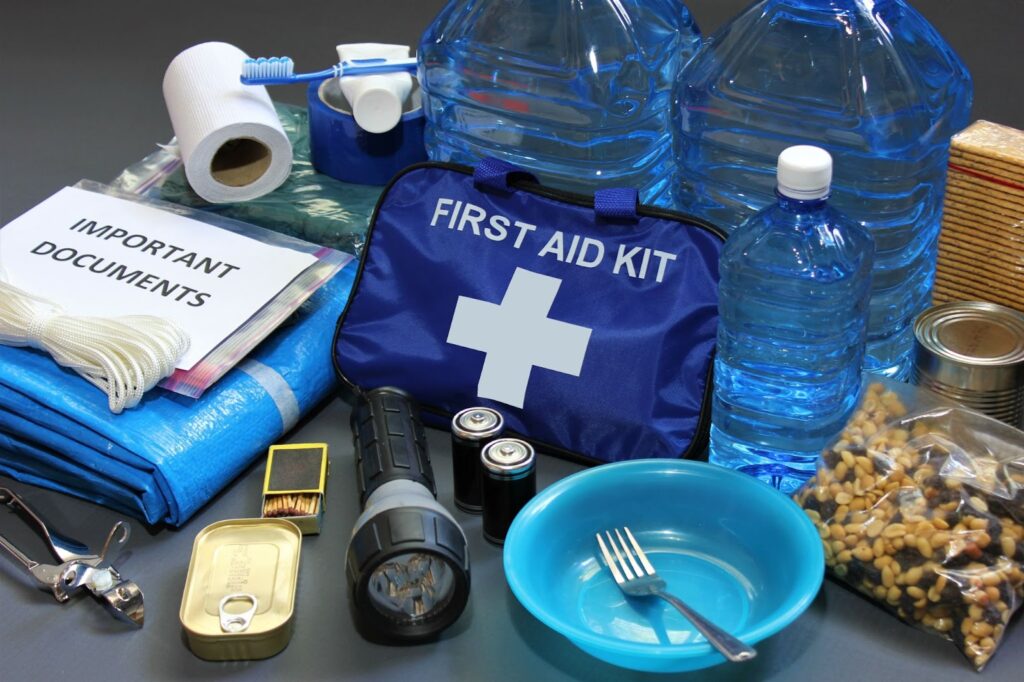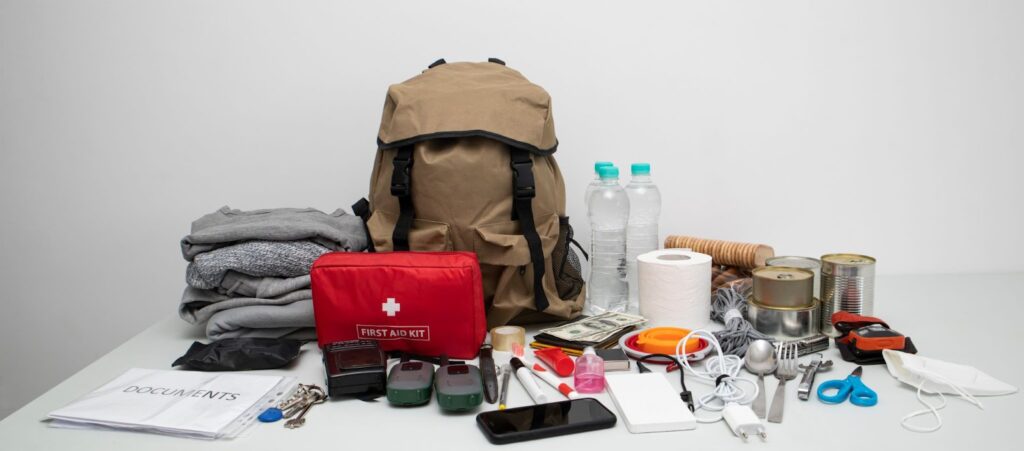Preparing for disaster is crucial when facing the unpredictable. Hurricanes, earthquakes, and sudden power outages can strike without warning, thrusting us into emergency situations. In these moments, a well-equipped disaster preparedness kit becomes your first line of defense, helping you and your family survive comfortably until help arrives.
This blog walks you through building a disaster preparedness kit that addresses various emergencies specific to your region. Knowing what to pack is essential, whether it’s storm gear, blackout supplies, or tools for natural disasters. We’ll cover everything from the basics of water and food to specialized equipment, ensuring you’re ready for anything.
Water supply
Water is a lifeline in any disaster, making it essential to have a sufficient supply. Each person needs about one gallon daily for drinking and sanitation, with a recommended minimum supply for three days. However, stocking up for a week will provide additional security.
For effective storage, use clean, food-grade containers, seal them tightly, and label them with the storage date. To maintain its freshness, refresh your water supply every six months. Large water barrels or dedicated storage systems are excellent options for those needing more substantial reserves.
Make sure to have methods to purify water in case of contamination. Portable filters, purification tablets, and boiling water are reliable purification methods. Filters remove pathogens, tablets are portable and convenient, and boiling kills bacteria and viruses.
Food supplies
Stock your disaster preparedness kit with non-perishable foods that require no refrigeration, cooking, or special preparation.
Choose canned meats, fruits, vegetables, and ready-to-eat dried foods such as nuts and granola bars. Include a can opener and cater to all family members by adding gluten-free, diabetic-friendly, or low-sodium options as needed. Remember to pack baby essentials like formula and baby food.
Prepare for power outages by packing disposable utensils and, if space permits, a portable stove or grill with fuel stored safely. Regularly refresh your food supplies to maintain freshness and accommodate dietary changes, ensuring your family stays nourished and resilient in emergencies.
First Aid Kit
Start by including all the essentials: various sizes of adhesive bandages, sterile gauze pads, adhesive tape, scissors, tweezers, antiseptic wipes, antibiotic ointment, a thermometer, instant cold packs, and disposable gloves for maintaining hygiene during treatment.
Add a tourniquet, splinting materials, and elastic wraps for severe injuries to help stabilize sprains and fractures. Always include a first aid manual for guidance on handling emergencies when professional medical help isn’t immediately accessible.
Tailor your kit to meet your family’s specific health needs. Stock a week’s supply of prescription medications, noting each medication’s details and doctor’s contact information. Add an extra pair of glasses or contact lenses with solution for those who need them.
Expand your kit to include medicines for broader health issues, such as pain relievers, allergy medications, asthma treatments, and antidiarrheal medicines. Regularly update and replenish your kit to ensure all items are fresh and effective; it’s essential to preparing for disaster.

Lighting and communication tools
Visibility and communication are critical in any disaster. Pack extra batteries and equip your preparedness kit with multiple light sources, including energy-efficient LED flashlights and headlamps. Include solar-powered or hand-crank flashlights for reliable, hands-free lighting and waterproof glow sticks for immediate illumination during emergencies.
For communication, add a battery-powered or hand-crank radio, many of which feature built-in device chargers, to receive weather updates and emergency broadcasts. Also, ensure you have a fully charged portable battery pack or solar charger for your mobile phones and other small electronics to maintain communication.
If your area experiences frequent power outages, include a traditional landline phone that operates without electricity. Store these tools where you can easily access them and regularly test them to ensure they are functional when needed.
Personal hygiene and sanitation supplies
Maintaining personal hygiene and sanitation during a disaster is vital for health and morale. Ensure your preparedness kit includes a comprehensive array of hygiene products to sustain cleanliness when typical facilities are unavailable.
Essential hygiene products:
- Toothbrushes and toothpaste.
- Soap and hand sanitizer.
- Moist towelettes.
- Shampoo.
- Feminine hygiene products.
- Toilet paper.
- Diapers and baby wipes.
Sanitation solutions:
- Portable toilet: Prepare for unavailable sewage services with a portable camping toilet or lined 5-gallon buckets.
- Disinfectants: Keep bleach and other disinfectants on hand, with instructions for proper dilution and usage.
- Garbage bags: Large, durable bags are used to collect waste and limit contamination.
- Personal waste bags: Stock commercially available bags that neutralize odors and break down waste. These are particularly useful if sewage systems fail.
Clothing and bedding
Ensuring your disaster preparedness kit includes suitable clothing and bedding is crucial for comfort and protection against the elements, regardless of climate.
Choosing the right clothing
Include items you can layer to adjust to changing temperatures, such as moisture-wicking base layers, insulating middle layers, and waterproof outer layers. Pack sturdy boots or shoes appropriate for rough terrain or debris-strewn areas, tailored to each family member’s size and needs.
Add cold-weather gear like hats and gloves or sun-protective clothing like long-sleeved shirts, depending on your climate.
Selecting bedding
Choose compact, climate-appropriate sleeping bags — weather-resistant for cold and breathable for warmth. Include thermal blankets that are compact for easy storage yet effectively retain heat. Space blankets are ideal for their lightweight and compact size.
Consider adding air mattresses or sleeping pads for extra comfort, especially during prolonged displacement.
Store all items in waterproof bags to keep them dry; vacuum-sealed bags help save space and protect against moisture. Keep clothing and bedding easily accessible, and consider a separate, smaller “go-bag” with essentials for rapid evacuation.
Important documents and cash
Keep your disaster preparedness kit ready with secure collections of crucial documents and accessible cash. Store copies of personal IDs, like passports and driver’s licenses, along with important legal documents, including wills and power of attorney forms.
Maintain up-to-date copies of health, home, and auto insurance policies for quick access to contacts and policy numbers after a disaster. Include health insurance cards, prescriptions, and essential medical records to ensure you can receive care or refill medications if displaced.
In disaster scenarios where ATMs and card systems may fail, having cash is essential for purchasing necessities or covering immediate expenses. Keep a reasonable amount of cash in small denominations to simplify transactions for essentials like food and lodging. Store both cash and documents in a waterproof, fireproof, portable container for quick evacuation if needed.
For enhanced security, maintain digital backups of all documents in secure cloud storage, accessible from any location with internet access. Regularly update your documents and cash reserves, checking for any expired IDs or outdated medical info.
Tools and emergency supplies
Building your disaster preparedness kit to include essential tools and supplies is critical for effectively managing repairs and responding to local hazards. Include a multi-tool or Swiss Army knife for versatility, duct tape for quick fixes, and basic hardware like screws and nails with appropriate tools for temporary repairs.
Store these tools in an accessible spot known to all family members and ensure they are in good working condition.
Special items
When building your disaster preparedness kit, ensure it meets the specific needs of every household member, including infants, the elderly, pets, and those with special medical requirements.
Pack essentials like baby formula, bottles, diapers, wipes, clothes, blankets, and soothing toys for infants and young children. Include any necessary medications and devices, such as nebulizers or inhalers.
For elderly family members, add extra eyeglasses, hearing aid batteries, orthopedic supports, and ensure mobility aids like canes or walkers are accessible and functional. Stock prescribed medications and commonly used over-the-counter products with clear dosage instructions.
For pets, separate their food and water from human supplies. Include dishes, a leash, a carrier, medications, a favorite toy, and bedding. Ensure you have their vaccination records stored in a waterproof container.
For individuals with special medical needs, include essential medical equipment like insulin pumps or oxygen tanks and ensure a power backup is available. Prepare a detailed list of all medical conditions with care instructions and contact information for doctors and pharmacies.

Be prepared for anything with Utah Disaster Clean Up and Restoration
Utah Disaster Clean Up is here to assist with any cleanup and restoration needs. Remember, while being prepared is crucial, knowing who to call when professional help is needed will make all the difference. Trust Utah Disaster Clean Up to be your partner in not only recovery, but in ensuring peace of mind during what is often a challenging time.
To learn more about preparing for disasters or to discover how we help protect your home, contact Utah Disaster Clean Up.



